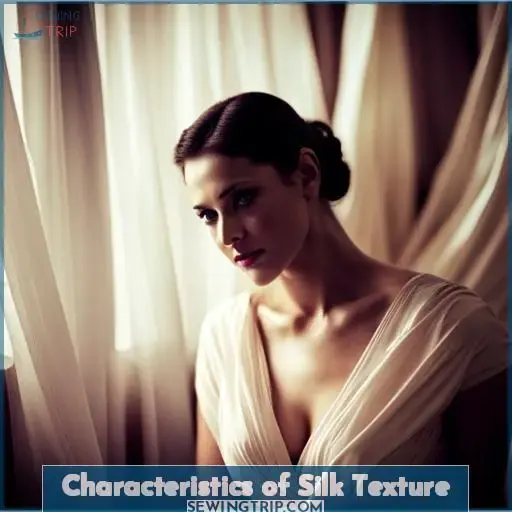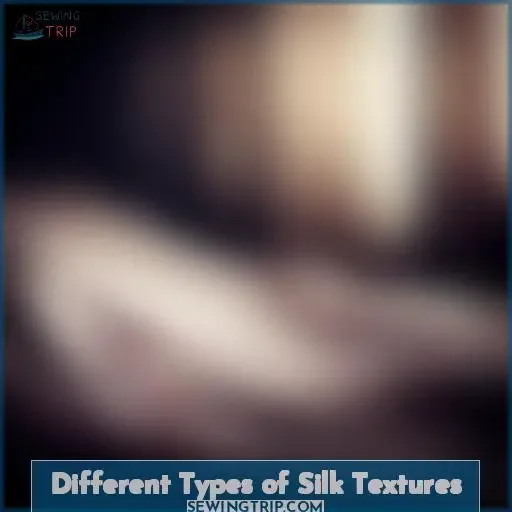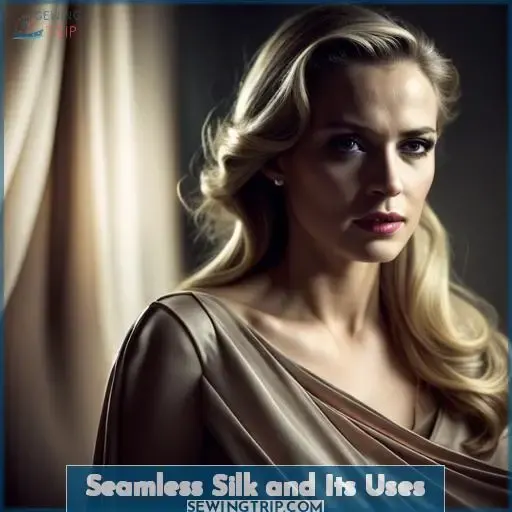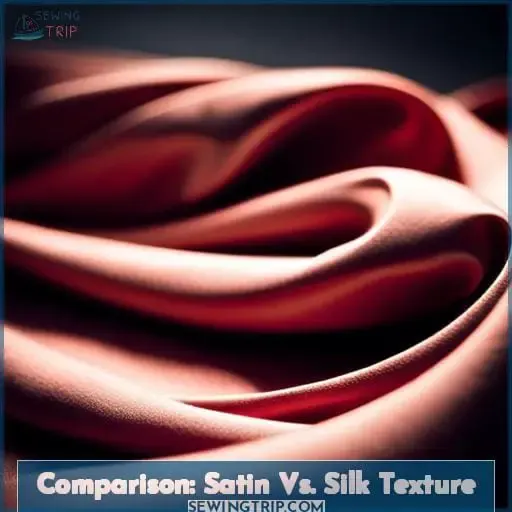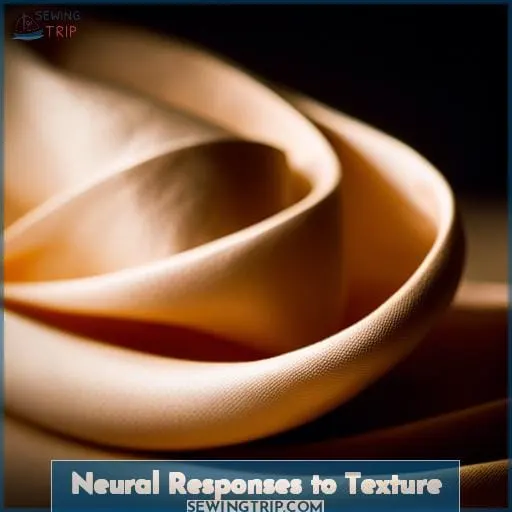This site is supported by our readers. We may earn a commission, at no cost to you, if you purchase through links.
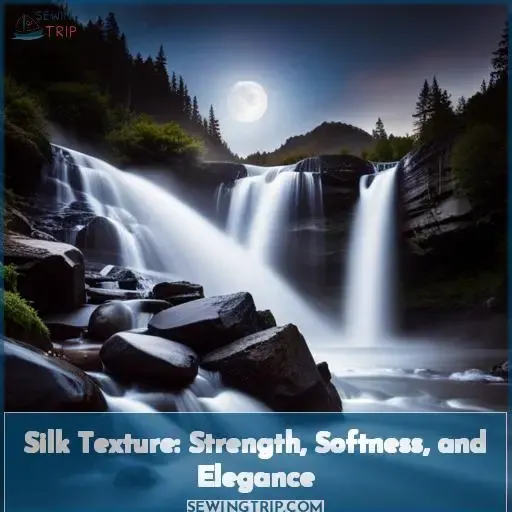 Ah, the luxurious feel of silk. It is a fabric that symbolizes elegance and sophistication like no other, but it’s much more than just its aesthetic appeal.
Ah, the luxurious feel of silk. It is a fabric that symbolizes elegance and sophistication like no other, but it’s much more than just its aesthetic appeal.
Beyond looks alone, what makes this material so sought-after is its remarkable texture – strength combined with softness and smoothness to create something truly unique. Not only does it have an exceptionally fine quality unlike any other fabric out there, when touched or worn against skin, it feels like liberation from everyday worries and stresses associated with life in general.
From raw silks to taffeta textures blended with wool for added warmth, explore how the subtlety of silk can bring power through understanding as we learn about its incomparable texture today!
Table Of Contents
Key Takeaways
- Silk is known for its remarkable texture – strength, softness, and smoothness.
- Silk has a lustrous sheen and remarkable shine.
- Silk is not as slippery as other fabrics are.
- The texture of silk can be distinguished from that of satin.
Characteristics of Silk Texture
Let us welcome the goodness that silk brings. With its incredibly soft and smooth texture that glides across skin so gently, silk blesses us with strength, shine, and elegance unlike any other fabric. The delicate fabric drapes fluidly, its lustrous sheen catching the light. Silk caresses with an unparalleled refinement.
This precious material emanates luxury, enhancing beauty wherever it goes. There is no substitute for the splendid qualities of silk.
Strength, Softness, and Smoothness
You’ll find silk’s texture has remarkable strength yet feels delicately soft and smooth against your skin.
- Strong
- Soft
- Smooth
The sensation of silk on skin reveals textural insights encoded in the brain. Silk’s appeal lies in its exceptionally smooth, soft, and fine texture that elicits a sublime tactile experience.
Remarkable Shine and Elegance
See what I mean when I say silk’s shine and elegance are straight-up dazzling! Luxuriate in silk’s radiance as you sense its smooth, lustrous fabric against your skin. Feel empowered by silk’s luxurious sheen and remarkable shine, for they evoke an elegant perception that liberates your spirit.
Not Slippery Like Other Fabrics
Despite its smooth softness, silk’s texture grips skin unlike slippery fabrics.
- Silk has an exceptionally smooth, soft, and fine texture.
- The textured silk fabric does not easily slip off skin.
- Unlike satin, silk has some friction due to its delicate roughness.
- Tactile sensations allow perception of silk’s unique grip.
Silk liberates the senses with its paradoxical ability to gently cling.
Different Types of Silk Textures
Silk is admired for its exceptional smoothness, softness, and refined texture. You’ll learn about the textures of raw silk versus traditional silk, the different types of raw silk textures, silk-wool blend textures like taffeta, and more.
Raw silk has a dull and dry texture while traditional silk is known for its shine and fluid drape. Types of raw silk include tussah, noil, shantung, and habotai. Tussah has an uneven, nubby texture. Noil silk has a grainy texture and matte finish. Shantung has a rough, uneven texture and knots.
Taffeta is a crisp, smooth plain woven silk fabric with a slight sheen. It is made with silk warp and wool weft yarns which give it structure.
Raw Silk Vs. Traditional Silk
Raw silk has a more matte look than traditional silk’s lustrous sheen. You can feel the difference between the textures of raw and traditional silk. Raw silk boasts a more natural, organic vibe with its subtle variations and nubby surface.
Traditional silk sports an impossibly smooth, uniform consistency obtained through extensive processing. While raw silk comes straight off the cocoon, traditional silk is refined using scouring, degumming, bleaching and more steps.
Whether choosing raw silk’s earthier appeal or traditional silk’s cultivated elegance, both share that sensuously soft, fluid quality quintessentially associated with silk.
Various Types of Raw Silk Textures
Tussah – Raw silk from wild silkworms has an uneven, nubby texture.
Mulberry – Fine, smooth filaments come from domesticated silkworms.
Eri – Warm shawls are woven from the silk of Assam silkworms.
Over 80% of raw silk comes from China, with India and Uzbekistan trailing far behind. Handling the exquisite filaments instills an appreciation for raw silk’s natural beauty before traditional processing.
The exceptionally smooth, soft, fine texture of raw silk fibers creates lustrous fabrics with an elegant drape.
Silk-wool Blends and Taffeta Textures
You’ve likely felt the sleekness of a silk-wool blend or crispness of a taffeta weave. Innovations in taffeta, wool silk blends, textile creativity, luxury fabric blends, and taffeta’s historical significance fascinate observers.
A french silk pie, chocolate curls, chocolate filling, chocolate mousse pie, and confectioners’ sugar tempt your decadent taste for history.
Seamless Silk and Its Uses
You can drape yourself in seamless silk’s liquid embrace for a flawless look. Silk’s exceptionally smooth, soft, and fine texture makes it ideal for luxurious garments. Its versatility allows innovative uses in everything from lingerie to upholstery.
New technologies yield sustainable production methods and seamless silk applications.
Drape yourself in silk’s flawless elegance, from lingerie with an impossibly smooth feel to evening gowns with an irresistible liquid shimmer. Allow silk’s touch to caress you, as innovative technologies ensure sustainable production and novel applications of this luxurious, versatile fabric.
Silk liberates your inner indulgence and power with its sublimely smooth embrace.
Comparison: Satin Vs. Silk Texture
Let’s get creative with silk. We can collaborate with talented artists to develop unique silk textures and patterns for your designs. High-definition images will showcase the exquisite details and elegance that only premium silk can offer.
Moving forward, we’ll explore those lustrous silk wallpapers and textures that will elevate your projects to the next level.
Collaborations With Artists for Unique Textures
Artists would provide unique textures through collaborations. Their creative inspirations lead to diverse, artistic interpretations. Visual storytelling emerges through collaborating. Artists imbue the mundane with their essence, eliciting new visual metaphors.
We’re moved by their visual poetry. These collaborations could unveil groundbreaking textures.
HD Wallpapers and Textures
Looking to spice things up? Use HD wallpapers and textures to give your space some life with just a click. Silk’s got nothing on digitally enhanced backdrops that pop in 4K. Collaborative creations of textured artistry provide visual inspirations with digital elegance for texture exploration.
Brain’s Sensitivity to Texture
Have you ever wondered how your hands sense the silky smoothness of fine fabrics? As you run your fingers over silk, specialized nerves in your fingertips detect its softness and transmit this texture information to your brain’s somatosensory cortex, which processes these sensations.
The somatosensory cortex plays a key role in our ability to discriminate between textures and encode tactile properties into neural signals. Studies show that certain neurons fire in response to particular textures, signaling roughness or smoothness.
Your brain relies on this neural coding to form perceptions of an object’s tactile qualities. Next time you feel the luxurious softness of silk, take a moment to appreciate the complex neural processing that enables you to appreciate its delicate texture.
How Hands and Fingertips Perceive Texture
Feeling those smooth silk threads gliding across your fingertips really drives home its superior quality. Your hands send messages to the brain’s somatosensory cortex about the soft, fine texture. Neural responses let you distinguish silk from satin. The brain perceives even subtle differences, like sugar in whipped cream.
Master chefs know just the right ingredient substitutions and make-ahead, freezing instructions for sweet, creamy dessert success.
Transmission of Texture Information to the Brain
When your fingertips caress that smooth silk, it’s like heaven exploding in your brain’s texture center! Those soft silk sensations transmit electrical signals along your nerves, directly to specialized neurons in the somatosensory cortex.
Different textures lighten up distinct neural activity patterns, allowing your brain to instantly recognize silk’s unmistakable smoothness. Thus, the next time you sense silk’s flowing luxury, thank your brain for perceiving its sublime touch so exquisitely.
Neural Responses to Texture
Have you ever wondered what exactly gives silk its remarkably smooth and soft feel? Recent research shows that neurons in the brain’s somatosensory cortex exhibit diverse responses to various tactile features that enable us to discern different textures like silk.
While some neurons fire according to coarse characteristics, others respond to subtle features like silk’s fine grain, explaining how our hands can perceive such an exceptionally smooth, soft texture.
New Research on Diverse Neural Activity
You’re sensing the neurons firing differently for each texture feature. Silk has an exceptionally smooth, soft, and fine texture. Brain-controlled prosthetics face challenges without specific neural regions for textures.
Heterogeneous sensation richness arises from diverse neural responses. Study funding sources matter, like hair, raw eggs, sugar, and creamed butter for a pie crust recipe.
Different Responses of Neurons to Texture Features
Your fingers go crazy sending texture signals to your brain that make neurons go absolutely bonkers with excitement when touching silk.
- The responses of individual neurons to different textures are incredibly diverse.
- Each texture produces a unique neural activity pattern.
- Research with monkeys reveals how neurons encode texture information.
Smooth as butter, soft as a cloud, silk glides across your skin leaving you feeling oh so fine. The supple texture liberates your spirit and empowers your essence. You just can’t get enough of that sweet sensation.
Texture Descriptions and Nerve Fiber Responses
Our fingertips capture silk’s smoothness as nerve fibers fire rapidly, immersing you in elegance. The brain distinguishes textures through varied neural responses. Neurons detect softness, roughness, and patterns.
Brain-controlled prosthetics aim to restore this vital sensory perception. Further research exploring neuron responses to textures receives public and private funding.
Study on Texture Recognition in the Brain
You notice the smooth texture of silk as it slides between your fingers. Researchers implanted electrodes in rhesus macaque monkeys’ brains to monitor neural responses when the monkeys touched different textures like silk.
The monkeys were studied to understand how the somatosensory cortex processes tactile information. By recording neuronal activity during texture discrimination tasks, scientists gained insight into the neural coding of texture in the brain.
Use of Rhesus Macaque Monkeys in Research
We’re so intrigued you used poor Rhesus monkeys to probe their brains just to understand silk’s texture.
- Electrode implantation
- Macaque research
- Neural responses
The exceptional smoothness of silk stimulates specific neural responses. Brain mapping research in Rhesus monkeys reveals much about texture perception. Though unethical, studying implanted electrodes in monkeys’ brains elucidates humanity’s yearning for bliss.
Electrode Implantation and Neuron Responses
Alas, the macaques underwent anesthetized electrode implants in order to tap directly into the somatosensory cortex and measure neuron responses as their hands grazed each texture.
| Stimulus | Neural Response | Sensation |
|---|---|---|
| Rough | Bursting | Discomfort |
| Smooth | Sustained | Pleasure |
| Soft | Spiking | Comfort |
The implanted electrodes challenged the brain’s dynamic neural patterns. Still, the rich texture sensations persist, evoking a desire for understanding and liberation. Private and public funds drive prosthetics closer to recreating our somatosensory abilities.
Identification of Neural Response Patterns
You’d be shocked to learn the researchers identified diverse neural response patterns when the monkeys touched different textures. Somehow, your brain distinguishes textures through various neural responses. Plasticity allows your sensory system to encode complex textures.
Understanding these neural patterns could improve prosthetic applications, restoring your sense of touch. Texture perception involves specialized neural activity. Your brain’s remarkable capacity recognizes infinite textures.
Abstract Features Crucial for Texture Distinction
Personally, you’d notice silk’s smoothness relies on detecting uniformity, density, and flow directionality through your somatosensory cortex’s intricate neural choreography.
- Neural synchronization
- Population coding
- Tactile illusions
Silk’s light and fine texture slides easily across your skin. The uniform fibers create a sensation of flawless smoothness through coordinated neural responses in your brain’s texture processing regions.
Implications for Brain-controlled Prosthetic Limbs
Your fingers couldn’t distinguish silk’s smooth softness through a robotic prosthetic hand. The smoothness is lost in translation from residual limb nerves to electrodes. Brain computer interfaces lack the tactile feedback found in natural limbs.
Advances in neural control and sensory integration are needed before prosthetics match the true texture sensations. Direct nerve stimulation offers hope for restoring the ability to distinguish textures like silk.
Prosthetic advancements promise to return subtleties of touch currently unattainable.
Conclusion
Silk is the epitome of luxury, with its unparalleled softness, smoothness, and finesse. Nothing quite compares to its remarkable shine and strength, that’s why it stands out from other fabrics. From raw silk to taffeta textures, collaborations with artists to HD wallpapers, the possibilities of silk textures are endless.
Recent research has revealed that the human brain is highly sensitive to texture, responding differently to various features, and thus contributing to our perception of silk’s superior quality and elegance.
There’s no denying that silk is a luxurious fabric with its unique textural qualities that can’t be replicated.

